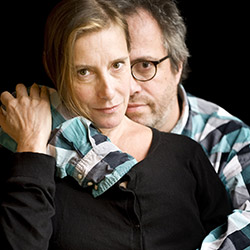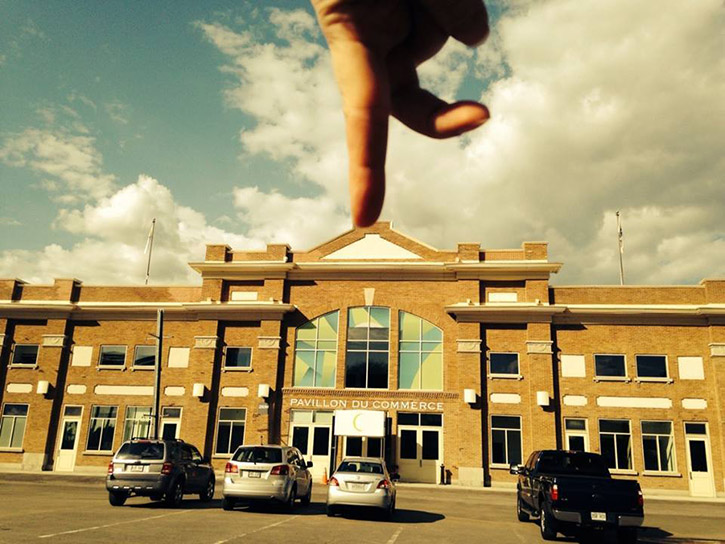Kiss & Cry: Ann Arbor Train Station
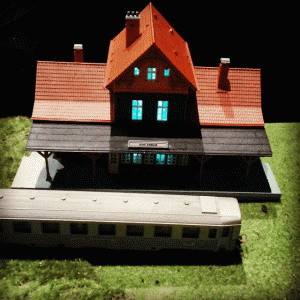
A weekend of Kiss & Cry performances at the Power Center is wrapped up! This miniature part of the set is the Ann Arbor train station.
Did you attend the performance? Don’t forget to tell us what you thought.
Artist Interview: Jaco van Dormael, Co-creator of Kiss & Cry
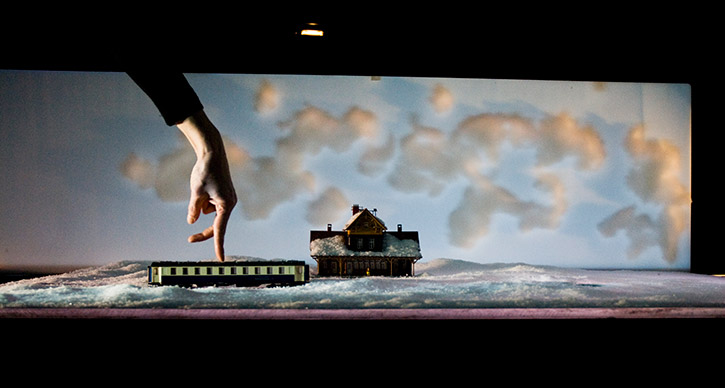
Photo: The set of Kiss & Cry, at Power Center October 10-12, 2014. Photo by Marteen Vanden Abelee.
Jaco van Dormael and Michèle Anne de Mey are bringing their one-of-a-kind finger ballet Kiss & Cry across the globe and to Ann Arbor. The performance runs at the Power Center October 10-12, 2014.
Dormael is a critically acclaimed Belgian film director and screenwriter, famous for his award-winning films, including his most recent cinematic hit, 2009’s Mr. Nobody. UMS Lobby contributor Greg Hicks recently spoke with Jaco van Dormael about the unique process of assembling Kiss & Cry, all the way from its minimal beginnings to its full-fledged stage production.
Gregory Hicks: How did you go about assembling the creative team for Kiss & Cry?
Jaco Van Dormael: [Michèle and I] had never worked together, so at the moment we were thinking “What could we do to work together?” She is a choreographer and I’m a movie maker. At the beginning, it was something that was new for everybody. Personally, I wanted to make something very little. I spent the last 10 years on a big film that I liked very much, so I wanted to do something small.
So, the challenge for me was: “Is it possible to make a long feature film on the table of the kitchen?” For Michèle, the question was, “Is it possible to dance only with hands?” We started improvising in the kitchen on the table with a tiny camera and a few friends — trying to figure out how it’s possible to give big feelings with tiny sets, and how it’s possible to make a sort of ephemeral film — a film that only exists in front of the audience, but nothing is ever recorded.
GH: How does the usage of hands (as opposed to traditional stage methods) change the presentation of the story?
JDV: The important thing is that the camera shows on the screen what is too little for the eye. [On stage],you will see bodies, but on screen you will only see hands. The eye can go from the stage to the screen and have a sort of double perception.
Even the way of filming is totally new for me because the mixing of the scales is something we rarely use in cinema — to have tiny houses and tiny sets. For example, one hand is sleeping in the bed, and the hand is smaller than the pillow. But when she wakes up, she’s bigger than the bed. And then she goes into the garden and the hand is bigger than the house! Because the scales are different, it’s possible to make images that are closer to dreams than reality.
And, there is no digital effect. All the special effects are made on the spot and visible with the eyes. For example, we have a house, and we can make the gravity of switch on and off just by filming something in the box and turning it, a sort of inverted gravity. We can make things that are nearly impossible to pay for in a feature film. With two bucks, we have incredible effects! And the audience sees how it’s done. It’s like a magic trick. You can tell that it’s a trick, but you believe it.
GH: How do you think the audience will handle seeing a performance in this way? Do you think it will take them a moment to get used to the two formats once the performance starts?
JDV: I have a feeling that the audience will click immediately into the process, because you have these dancing hands from the beginning. [The audience] enjoys something that is different but familiar, a film made just for them. It’s an experience you cannot have by watching a film on DVD, and it’s an experience you cannot have in theatre either. It’s something new, something that wasn’t possible ten years ago because the tiny cameras we use didn’t exist 10 years ago. For example, we have a train that is turning around, and there are three little cameras in the train that give the feeling that we’re speeding in a large country.
GH: The students and community of Ann Arbor are always thrilled to see experimental shows. How do you feel about bringing your show to a city like as this?
JDV: It’s a joy because I think it’s made for people who want to see new things. It also works very well with young people because they already have that habit of figuring out what is possible to make [with video devices]. One of the most enjoyable remarks I heard from the audience was from a young guy who said to me, “What kills me is that these kinds of shows are made by old people!”
At the moment, we’ve played [the performance] more than 200 times in 8 different languages. It doesn’t look like a foreign theatre piece. People always see it in their own language, whether we play it in Korean or in Spanish or in German or in Dutch or in Italian. It’s always in the language of the country, so I don’t think [Ann Arbor] will need to study for anything.
Interested in more? Watch the video trailer for the performance, featuring UMS director of programming Michael Kondziolka.
Kiss & Cry and Push Boundaries
UMS director of programming Michael Kondziolka on why he’s excited about the upcoming boundary-pushing film, theater, and dance work Kiss & Cry. Charleroi Danses perform Kiss & Cry at the Power Center October 10-12.
Performing Objects: Beyond Puppetry
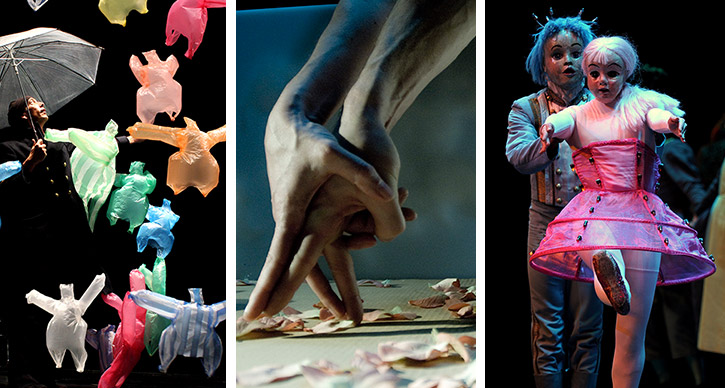
Examples of object performance abound in our 2014-2015 season. From left to right, Prelude to the Afternoon of a Foehn, Kiss & Cry, and Cinderella. Photos courtesy of the artists.
A plastic bag caught in the wind. Two hands intertwined in a miniature embrace. A doll-like mask covering a dancer’s face.
Each of these performing objects will make an appearance on a UMS stage this season.
But what exactly are “performing objects”? Are they puppets? Or something else?
In the 1980s, puppet scholar Frank Proschan defined “performing objects” as “material images of humans, animals or spirits that are created, displayed, or manipulated in narrative or dramatic performance.” By design, this is an exceedingly broad umbrella term; performing objects include but exceed traditional definitions of puppetry, which are themselves expanding. As scholar Claudia Orenstein describes it, “When we say ‘puppet’ we are no longer speaking exclusively of the figurative, crafted characters dangled from strings, gloved on hands, or attached to rods that the word had previously evoked: the Punch, Guignol, Howdy Doody, Lamb Chop, Kukla and Kermit characters of our childhoods.”
Performing objects multiply the physical, psychological and emotional possibilities of what can be done on stage. Objects have movement capacities that humans do not possess; though objects can be anthropomorphized and ascribed humanlike emotional qualities, they are often used to push the boundaries of what is acceptable or tasteful, in ways that would be more difficult for audiences to accept with a human performer.
Last season, UMS audiences saw three masterful performances of puppetry. The UK’s Blind Summit created both the series of life-size puppets representing the title character in Complicite’s Shun-kin and the pint-size Biblical imp Moses in The Table; though these puppets were very different in appearance and in the role they played in each production, all were created in the bunraku tradition from Japan, which utilizes three puppeteers to operate each puppet. Our audiences were also able to see the work of another modern puppet innovator, South Africa’s Handspring Puppet Company, in our National Theatre Live broadcast of War Horse. Their massive, startlingly beautiful and emotionally resonant horse puppets for that piece are critical to the impact of that World War I tale, which has played to great acclaim worldwide.
This season builds on those experiences and provides several rich examples of “performing objects” in Kiss & Cry, Prelude to the Afternoon of a Foehn, and Cinderella, where objects take on a degree of humanity, and human bodies and body parts are rendered as objects.
Behind the scenes with Kiss & Cry:
In Kiss & Cry hands, anatomized in close-up on projected film images, stand in for the whole person; the work’s dramatization of romantic entanglements takes on a level of revelatory strangeness while still maintaining the intimacy of genuine human contact. In Lyon Opera Ballet’s Cinderella, the traditional romance of the fairy tale and Prokofiev’s score are undercut and made humorous by the prominent use of toys on stage. Additionally, the dancers themselves are depicted as toys: faces covered in doll-like masks, they also move with the articulated stiffness of dolls.
A selection from the performance of Prelude to the Afternoon of a Foehn:
In Prelude to the Afternoon of a Foehn, everyday plastic shopping bags dance their own kind of ballet, manipulated by a single human performer and a series of electric fans. Tied to mimic the human form, reminiscent of balloon animals in a variety of bold colors, the bags beautifully illustrate Debussy’s score and complicate our notions of these objects as trash.
Performing objects mimic, illuminate, and make strange both the human form and human experience. Using a variety of materials, from the elevated to the everyday, the artists creating these works invite us to see the world in new and marvelous ways.
Have questions for Shannon? Ask them in the comments below.
Kiss & Cry Nano Dance Contest
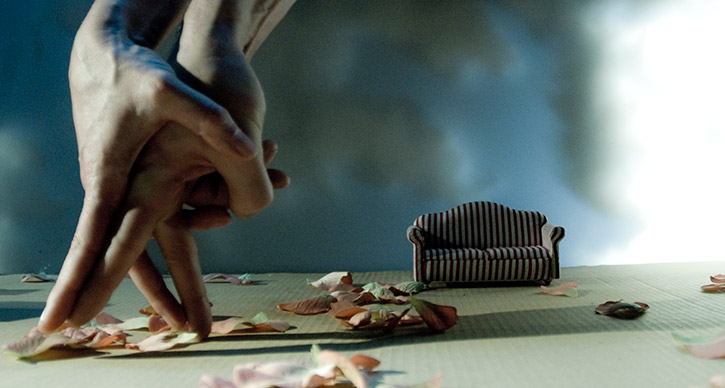
Photo: A scene from Kiss & Cry. Photo by Marteen Vanden Abeele.
A diverse group of Belgian artists is coming together to perform Kiss & Cry in Ann Arbor on October 10-12. The work is a blend of film, dance, text, and theater; the audience witnesses a film screened and simultaneously made in front of their eyes. Hands visually portray the main characters, as in the photo above.
The company calls these vignettes “nano dances,” and for this contest, we’re asking you to try your hand (get it?) at nano-dancing yourself.
What: A contest of nano-dances. Three winners will receive a pair of tickets to see Kiss & Cry.
How to enter: Create a nano-dance using your hands. The setting is up to you (Ann Arbor has many landmarks and picturesque locations!). Enter your dance video, or a still photo of a moment in your dance, via Facebook, Twitter, or Instagram.
- On Facebook, enter by posting a photo or video on our wall. Be sure to include #umslobby in your photo description.
- On Twitter, enter by tweeting a photo @UMSNews. Be sure to include #umslobby in your photo description.
- On Instagram, enter by posting a photo or video with #umslobby. Note: If your account is set to “private” we won’t be able to see your entry!
Contest timeline: September 22 at 9 am – October 3 at 5 pm.
Questions? Ask them in the comments below.
For inspiration, a photo submitted by the company from a visit to France. Courtesy of the artists.
Behind the Scenes with Kiss & Cry
It’s dance. It’s theater. It’s film. Kiss & Cry seamlessly blends artistic disciplines to create a wholly unique DIY aesthetic that is captivating audiences around the world. Go behind the scenes with the group of Belgian artists who will being this production to Ann Arbor October 10-12.


